Features of Secular Changes in the Flux Density of the Cas a Supernova Remnant, from Centimeter to Decameter Wavelengths
Abstract
1. Introduction
2. Materials and Methods
3. Results
3.1. Evolution of the Spectra Cas A and Cyg A
3.2. Secular Decrease in the Flux of Cassiopeia A in the Centimeter and Millimeter Radio Bands
3.3. Secular Decrease in the Flux of Cassiopeia A in the Decimeter Radio Band
3.4. Secular Decrease in the Flux of Cassiopeia A in the Meter Radio Band
3.5. Results of the Cas A Observations in the Decameter Radio Band with the UTR-2 and GURT Radio Telescopes
3.6. Results of Monitoring the Cas A Observations in the Decameter Radio Band with the URAN-4 Radio Telescope
3.7. Observations of the Cas A with Radio Telescopes of the Ventspils International Radio Astronomy Center, Latvia
3.8. Comparison of Solar Wind Variations with Radio Observations of the Cas A
3.9. Stability of the Radio Galaxy Cyg A in the Decameter Radio Band
4. Discussion
5. Conclusions
Author Contributions
Funding
Institutional Review Board Statement
Informed Consent Statement
Data Availability Statement
Acknowledgments
Conflicts of Interest
Appendix A
| Time, Years | CasA/CygA, 20 MHz | Std.Err. (20 MHz) | Time, Years | CasA/CygA, 25 MHz | Std.Err. (25 MHz) |
|---|---|---|---|---|---|
| 1987.1 | 1.54 | 0.08 | 1987.1 | 1.42 | 0.09 |
| 1987.2 | 1.52 | 0.12 | 1987.2 | 1.47 | 0.10 |
| 1987.3 | 1.51 | 0.08 | 1987.3 | 1.42 | 0.10 |
| 1987.4 | 1.48 | 0.10 | 1987.4 | 1.36 | 0.07 |
| 1987.7 | 1.53 | 0.16 | 1987.8 | 1.64 | 0.10 |
| 1987.8 | 1.60 | 0.15 | 1987.9 | 1.63 | 0.10 |
| 1987.9 | 1.54 | 0.09 | 1988.0 | 1.51 | 0.13 |
| 1988.0 | 1.57 | 0.14 | 1988.1 | 1.62 | 0.12 |
| 1988.1 | 1.52 | 0.14 | 1988.2 | 1.43 | 0.10 |
| 1988.2 | 1.39 | 0.09 | 1988.3 | 1.51 | 0.18 |
| 1988.3 | 1.47 | 0.15 | 1988.4 | 1.51 | 0.22 |
| 1988.3 | 1.51 | 0.18 | 1988.5 | 1.58 | 0.18 |
| 1988.4 | 1.43 | 0.16 | 1988.6 | 1.69 | 0.41 |
| 1988.5 | 1.75 | 0.18 | 1988.8 | 1.49 | 0.18 |
| 1988.6 | 1.57 | 0.17 | 1988.9 | 1.47 | 0.21 |
| 1988.9 | 1.53 | 0.15 | 1989.1 | 1.52 | 0.36 |
| 1989.0 | 1.59 | 0.21 | 1989.2 | 1.15 | 0.22 |
| 1989.1 | 1.52 | 0.31 | 1989.3 | 1.76 | 0.93 |
| 1989.2 | 1.59 | 0.31 | 1989.3 | 1.45 | 0.25 |
| 1989.3 | 1.66 | 0.73 | 1989.5 | 1.43 | 0.25 |
| 1989.3 | 1.47 | 0.32 | 1989.6 | 1.38 | 0.26 |
| 1989.5 | 1.40 | 0.26 | 1989.7 | 1.52 | 0.29 |
| 1989.6 | 2.02 | 0.72 | 1989.8 | 1.40 | 0.13 |
| 1989.7 | 1.45 | 0.20 | 1989.8 | 1.38 | 0.11 |
| 1989.8 | 1.21 | 0.13 | 1989.9 | 1.47 | 0.13 |
| 1989.8 | 1.42 | 0.10 | 1990.3 | 1.50 | 0.16 |
| 1989.9 | 1.52 | 0.13 | 1990.4 | 1.76 | 0.42 |
| 1990.3 | 1.40 | 0.10 | 1991.0 | 1.42 | 0.17 |
| 1990.4 | 1.49 | 0.15 | 1991.1 | 1.62 | 0.21 |
| 1991.0 | 1.47 | 0.16 | 1991.4 | 1.61 | 0.17 |
| 1991.2 | 1.64 | 0.12 | 1991.5 | 2.54 | 0.30 |
| 1991.4 | 1.54 | 0.17 | 1991.6 | 1.69 | 0.15 |
| 1991.5 | 1.90 | 0.50 | 1991.8 | 2.16 | 0.17 |
| 1991.6 | 2.16 | 0.09 | 1991.8 | 1.41 | 0.15 |
| 1991.7 | 2.20 | 0.14 | 1992.5 | 1.46 | 0.15 |
| 1991.8 | 1.36 | 0.16 | 1992.6 | 1.34 | 0.17 |
| 1992.5 | 1.93 | 0.13 | 1992.7 | 1.68 | 0.13 |
| 1992.6 | 2.04 | 0.31 | 1992.8 | 1.40 | 0.10 |
| 1992.7 | 1.79 | 0.17 | 1992.8 | 1.48 | 0.12 |
| 1992.8 | 1.45 | 0.12 | 1993.0 | 1.66 | 0.47 |
| 1992.8 | 1.52 | 0.13 | ------- | ------- | ------- |
| Time, Years | CasA/CygA, 20 MHz | Std.Err. (20 MHz) | Time, Years | CasA/CygA, 25 MHz | Std.Err. (25 MHz) |
|---|---|---|---|---|---|
| 1998.6 | 1.75 | 0.05 | 1998.8 | 2.22 | 0.07 |
| 1998.7 | 1.84 | 0.17 | 1998.8 | 1.90 | 0.17 |
| 1998.9 | 2.41 | 0.42 | 1998.9 | 1.72 | 0.18 |
| 1998.9 | 3.15 | 0.90 | 1998.9 | 1.72 | 0.31 |
| 1999.1 | 1.68 | 0.13 | 1999.1 | 2.02 | 0.21 |
| 1999.1 | 1.45 | 0.19 | 1999.1 | 1.41 | 0.17 |
| 1999.1 | 1.67 | 0.15 | 1999.1 | 1.55 | 0.15 |
| 1999.2 | 1.71 | 0.13 | 1999.2 | 1.75 | 0.09 |
| 1999.2 | 1.82 | 0.14 | 1999.2 | 1.75 | 0.12 |
| 1999.3 | 1.57 | 0.08 | 1999.3 | 1.57 | 0.10 |
| 1999.3 | 1.60 | 0.08 | 1999.3 | 1.68 | 0.07 |
| 1999.3 | 1.66 | 0.09 | 1999.3 | 1.79 | 0.21 |
| 1999.4 | 1.51 | 0.18 | 1999.4 | 1.55 | 0.19 |
| 1999.4 | 1.36 | 0.18 | 1999.4 | 1.33 | 0.19 |
| 1999.4 | 1.00 | 0.21 | 1999.4 | 1.00 | 0.21 |
| 1999.5 | 1.33 | 0.10 | 1999.5 | 1.11 | 0.03 |
| 1999.7 | 1.10 | 0.10 | 1999.7 | 1.22 | 0.14 |
| 1999.7 | 1.09 | 0.04 | 1999.8 | 1.06 | 0.08 |
| 1999.8 | 1.24 | 0.06 | 1999.8 | 1.09 | 0.08 |
| 1999.8 | 1.41 | 0.05 | 1999.9 | 1.25 | 0.01 |
| 1999.8 | 0.98 | 0.11 | 2000.0 | 1.47 | 0.18 |
| 2000.0 | 1.65 | 0.15 | 2000.1 | 0.95 | 0.14 |
| 2000.1 | 1.01 | 0.06 | 2000.1 | 1.10 | 0.24 |
| 2000.1 | 0.89 | 0.23 | 2000.5 | 1.23 | 0.15 |
| 2000.2 | 0.79 | 0.01 | 2000.6 | 1.07 | 0.15 |
| 2000.5 | 1.12 | 0.21 | 2001.0 | 1.85 | 0.18 |
| 2000.6 | 1.19 | 0.21 | 2001.1 | 1.80 | 0.23 |
| 2001.0 | 1.00 | 0.12 | 2001.1 | 2.55 | 0.49 |
| 2001.1 | 1.91 | 0.10 | 2001.1 | 1.65 | 0.16 |
| 2001.1 | 1.58 | 0.25 | 2001.2 | 2.23 | 0.51 |
| 2001.1 | 2.24 | 0.24 | 2001.2 | 1.57 | 0.27 |
| 2001.2 | 1.40 | 0.39 | 2001.3 | 1.13 | 0.16 |
| 2001.2 | 1.69 | 0.21 | 2001.3 | 1.30 | 0.16 |
| 2001.3 | 1.45 | 0.17 | ------- | ------- | ------- |
| 2001.3 | 1.67 | 0.38 | ------- | ------- | ------- |
| Time, Years | Intensity (25 MHz) | Std.Err.+ | Std.Err.– | Time, Years | Intensity (25 MHz) | Std.Err.+ | Std.Err.– |
|---|---|---|---|---|---|---|---|
| 1998.686 | 0.68 | 0.01 | 0.08 | 2002.619 | 0.56 | 0.02 | 0.14 |
| 1999.085 | 1.57 | 0.14 | 0.38 | 2002.647 | 0.96 | 0.02 | 0.12 |
| 1999.162 | 1.31 | 0.01 | 0.12 | 2002.666 | 0.77 | 0.02 | 0.15 |
| 1999.190 | 1.34 | 0.02 | 0.15 | 2002.678 | 1.36 | 0.05 | 0.23 |
| 1999.215 | 1.30 | 0.01 | 0.09 | 2002.693 | 1.41 | 0.05 | 0.21 |
| 1999.232 | 1.25 | 0.01 | 0.11 | 2002.708 | 1.14 | 0.10 | 0.31 |
| 1999.275 | 1.36 | 0.02 | 0.12 | 2002.723 | 1.09 | 0.05 | 0.23 |
| 1999.293 | 1.50 | 0.03 | 0.17 | 2003.503 | 1.39 | 0.01 | 0.11 |
| 1999.308 | 1.37 | 0.00 | 0.06 | 2003.538 | 1.23 | 0.03 | 0.18 |
| 1999.327 | 1.27 | 0.02 | 0.13 | 2003.595 | 1.26 | 0.05 | 0.22 |
| 1999.356 | 1.28 | 0.02 | 0.13 | 2003.612 | 0.90 | 0.07 | 0.27 |
| 1999.375 | 1.07 | 0.03 | 0.16 | 2003.637 | 1.16 | 0.05 | 0.23 |
| 1999.397 | 1.16 | 0.02 | 0.12 | 2003.701 | 1.56 | 0.21 | 0.45 |
| 1999.430 | 1.00 | 0.02 | 0.13 | 2003.747 | 1.40 | 0.02 | 0.13 |
| 1999.489 | 1.16 | 0.12 | 0.34 | 2003.782 | 1.47 | 0.01 | 0.07 |
| 1999.679 | 1.13 | 0.01 | 0.11 | 2003.812 | 1.44 | 0.05 | 0.22 |
| 2000.519 | 1.08 | 0.04 | 0.21 | 2003.845 | 1.43 | 0.00 | 0.07 |
| 2001.221 | 0.85 | 0.01 | 0.07 | 2003.892 | 1.49 | 0.01 | 0.09 |
| 2001.244 | 0.82 | 0.00 | 0.05 | 2003.910 | 0.75 | 0.18 | 0.42 |
| 2001.255 | 0.87 | 0.00 | 0.06 | 2003.996 | 1.29 | 0.02 | 0.14 |
| 2001.288 | 0.89 | 0.01 | 0.07 | 2004.007 | 1.42 | 0.01 | 0.10 |
| 2001.379 | 0.89 | 0.00 | 0.04 | 2004.025 | 1.12 | 0.12 | 0.35 |
| 2001.452 | 0.85 | 0.07 | 0.26 | 2004.071 | 1.38 | 0.02 | 0.16 |
| 2001.477 | 0.90 | 0.01 | 0.08 | 2004.090 | 1.44 | 0.02 | 0.13 |
| 2001.504 | 0.76 | 0.02 | 0.14 | 2004.117 | 1.41 | 0.01 | 0.12 |
| 2001.534 | 0.77 | 0.01 | 0.11 | 2004.167 | 1.32 | 0.10 | 0.31 |
| 2001.549 | 0.84 | 0.00 | 0.05 | 2004.197 | 1.39 | 0.02 | 0.12 |
| 2001.562 | 0.82 | 0.06 | 0.25 | 2004.235 | 1.48 | 0.01 | 0.08 |
| 2001.586 | 0.71 | 0.01 | 0.12 | 2004.266 | 1.13 | 0.11 | 0.33 |
| 2001.658 | 0.80 | 0.01 | 0.12 | 2004.284 | 1.33 | 0.03 | 0.16 |
| 2001.736 | 0.82 | 0.01 | 0.09 | 2004.311 | 1.20 | 0.07 | 0.26 |
| 2002.182 | 1.15 | 0.04 | 0.21 | 2004.355 | 1.55 | 0.02 | 0.13 |
| 2002.196 | 1.09 | 0.04 | 0.21 | 2004.399 | 1.54 | 0.01 | 0.12 |
| 2002.281 | 1.08 | 0.01 | 0.08 | 2004.436 | 1.48 | 0.02 | 0.13 |
| 2002.310 | 1.32 | 0.01 | 0.09 | 2004.469 | 1.51 | 0.07 | 0.26 |
| 2002.351 | 0.52 | 0.00 | 0.05 | 2004.503 | 1.42 | 0.03 | 0.18 |
| 2002.375 | 0.37 | 0.01 | 0.07 | 2004.525 | 1.71 | 0.56 | 0.75 |
| 2002.414 | 1.06 | 0.05 | 0.23 | 2004.552 | 1.66 | 0.07 | 0.26 |
| 2002.440 | 0.92 | 0.06 | 0.25 | 2004.734 | 1.48 | 0.06 | 0.24 |
| 2002.466 | 1.16 | 0.03 | 0.19 | 2004.870 | 1.46 | 0.02 | 0.14 |
| 2002.489 | 1.06 | 0.05 | 0.21 | 2004.883 | 1.31 | 0.02 | 0.13 |
| 2002.555 | 0.92 | 0.04 | 0.20 | 2004.893 | 1.39 | 0.01 | 0.09 |
| 2002.567 | 1.02 | 0.02 | 0.12 | 2004.933 | 1.33 | 0.09 | 0.30 |
| 2002.589 | 0.87 | 0.05 | 0.22 | ------- | ------- | ------- | ------- |
References
- Shklovsky, I.S. Possible secular variation of the flux and intensity of radio emission from some discrete sources. Astron. J. 1960, 37, 256–264. [Google Scholar]
- Lamden, R.J.; Lovell, A.C.B. The low-frequency spectrum of Cygnus A and Cassiopeia A. In Radio Astronomy, Proceedings of the 4th IAU Symposium, International Astronomical Union, Macclesfield, UK, 25–27 August 1955; Symposium No., 4; Van de Hulst, H.C., Ed.; Cambridge University Press: Cambridge, UK, 1957; p. 145. [Google Scholar]
- Erickson, W.C.; Perley, R.A. An anomaly in the flux of Cassiopeia A at 38 MHz. Astrophys. J. 1975, 200 Pt 2, L83–L87. [Google Scholar] [CrossRef]
- Bridle, A.H. Flux densities of Cassiopeia A and Cygnus A at 10.05 MHz. Observatory 1967, 87, 60–63. [Google Scholar]
- Tuffs, R.J. The Expansion of Cassiopeia A. In Supernova Remnants and their X-ray Emission, Proceedings of the International Astronomical Union Symposium No. 101, Venice, Italy, 30 August–2 September 1982; Springer: Heidelberg, Germany, 1983; Volume 101, pp. 49–54. [Google Scholar]
- Helmboldt, J.F.; Kassim, N.E. The evolution of Cassiopeia A at low radio frequencies. Astron. J. 2009, 138, 838. [Google Scholar] [CrossRef]
- Högbom, J.A.; Shakeshaft, J.R. Secular variations of the flux density of the radio source Cassiopeia A. Nature 1961, 189, 561–562. [Google Scholar] [CrossRef]
- De Gasperin, F.; Vink, J.; McKean, J.P.; Asgekar, A.; Avruch, I.; Bentum, M.J.; Blaauw, R.; Bonafede, A.; Broderick, J.W.; Brüggen, M.; et al. Cassiopeia A, Cygnus A, Taurus A, and Virgo A at ultra-low radio frequencies. Astron. Astrophys. 2020, 635, A150. [Google Scholar] [CrossRef]
- Tananbaum, H. Cassiopeia A. Int. Astron. Union Circ. 1999, 7246, 1. [Google Scholar]
- VanderPlas, J.T. Understanding the Lomb–Scargle Periodogram. Astrophys. J. Suppl. Ser. 2018, 236, 16. [Google Scholar] [CrossRef]
- Jacobsen, E.; Lyons, R. The sliding DFT. IEEE Signal Process. Mag. 2003, 20, 74–80. [Google Scholar]
- Christian, H. Reinsch. Smoothing by Spline Functions. Numer. Math. 1967, 10, 177–183. [Google Scholar]
- Chernov, I.A. Interpretation of the Sedov solution as a series of intermediate asymptotics in the flow from a strong explosion. Izvestiya VUZ. Appl. Nonlinear Dyn. 2010, 18, 33. [Google Scholar]
- McKee, C.F. X-ray emission drom an inward-propagating shock in young supernova remnants. Astrophys. J. 1974, 188, 335–339. [Google Scholar] [CrossRef]
- Jones, T.W.; Rudnick, L.; Jun, B.I.; Borkowski, K.J.; Dubner, G.; Frail, D.A.; Kang, H.; Kassim, N.E.; McCray, R. 1051 Ergs: The Evolution of Shell Supernova Remnants. Publ. Astron. Soc. Pac. 1998, 110, 125–151. [Google Scholar] [CrossRef]
- Vinyaykin, E.N. Evolution of the radio emission spectrum of Cassiopeia A based on long-term observations at frequencies 290 and 927 MHz. Astron. J. 2007, 84, 105–114. [Google Scholar]
- Vinyaykin, E.N. About the frequency dependence of the evolution of radio emission from the supernova remnant Cassiopeia A. Astron. J. 2014, 91, 720–734. [Google Scholar]
- Salas, P.; Oonk, J.B.R.; van Weeren, R.J.; Salgado, F.; Morabito, L.K.; Toribio, M.C.; Emig, K.; Röttgering, H.J.A.; Tielens, A.G.G.M. LOFAR observations of decameter carbon radio recombination lines towards Cassiopeia A. Mon. Not. R. Astron. Soc. 2017, 467, 2274–2287. [Google Scholar] [CrossRef]
- Asgekar, A.; Oonk, J.B.R.; Yatawatta, S.; Van Weeren, R.J.; McKean, J.P.; White, G.; Jackson, N.; Anderson, J.; Avruch, I.M.; Batejat, F.; et al. LOFAR detections of low-frequency radio recombination lines towards Cassiopeia A. Astron. Astrophys. 2013, 551, L11. [Google Scholar] [CrossRef]
- Dent, W.A.; Aller, H.D.; Olsen, E.T. The Evolution of the Radio Spectrum of Cassiopeia A. Astrophys. J. 1974, 188, L11. [Google Scholar] [CrossRef]
- DeLaney, T.; Rudnick, L.; Stage, M.D.; Smith, J.D.; Isensee, K.; Rho, J.; Allen, G.E.; Gomez, H.; Kozasa, T.; Reach, W.T.; et al. The three-dimensional structure of Cassiopeia A. Astrophys. J. 2010, 725, 2038. [Google Scholar] [CrossRef]
- Blondin, J.M.; Ellison, D.C. Rayleigh-Taylor Instabilities in Young Supernova Remnants Undergoing Efficient Particle Acceleration. arXiv 2001, arXiv:astro-ph/0104024v2. [Google Scholar] [CrossRef]
- Konovalenko, A.A. I.S. Shklovsky and low-frequency radio astronomy. Radiophys. Radio Astron. 2017, 22, 7–30. [Google Scholar] [CrossRef]
- Ivanov, V.P.; Stankevich, K.S. Periodic variations of the radio emission and evolution of the spectrum of the supernova remnant Cassiopeia A. Sov. Astron. 1989, 33, 15. [Google Scholar]
- Stankevich, R.S.; Ivanov, V.P.; Stolyarov, S.P. Fifty Years of Radio Observations of the Discrete Source Cassiopeia A. Astron. Lett. 1999, 25, 501–507. [Google Scholar]
- Barabanov, A.P.; Ivanov, V.P.; Stankevich, K.S.; Stolyarov, S.P. Evolution of the Cassiopeia A radio spectrum: Evidence for cyclic variability. Sov. Astron. 1986, 30, 549. [Google Scholar]
- Cigan, P.; Matsuura, M.; Gomez, H.L.; Indebetouw, R.; Abellán, F.; Gabler, M.; Richards, A.; Alp, D.; Davis, T.A.; Janka, H.-T.; et al. High Angular Resolution ALMA Images of Dust and Molecules in the SN 1987A Ejecta. Astrophys. J. 2019, 886, 51. [Google Scholar] [CrossRef]
- Vinyajkin, E.N.; Razin, V.A. Secular Decreases in the 927 MHz Emission from the Supernova Remnants Cas A and Tau A. Aust. J. Phys. 1979, 32, 93. [Google Scholar] [CrossRef][Green Version]
- Vinyajkin, E.N.; Razin, V.A. Secular Decrease and Random Variations of Cassiopeia A at 151.5 and 927 MHz. arXiv 2004, arXiv:astro-ph/0412593. [Google Scholar]
- Baars, J.W.M.; Genzel, R.; Pauliny-Toth, I.I.K.; Witzel, A. The Absolute spectrum of Cas A: An Accurate Flux Density Scale and Set of Secondary Calibrators. Astron. Astrophys 1977, 61, 99–106. [Google Scholar]
- Trotter, A.S.; Reichart, D.E.; Egger, R.E.; Stýblová, J.; Paggen, M.L.; Martin, J.R.; Dutton, D.A.; Reichart, J.E.; Kumar, N.D.; Maples, M.P.; et al. The fading of Cassiopeia A, and improved models for the absolute spectrum of primary radio calibration sources. Mon. Not. R. Astron. Soc. 2017, 469, 1299–1313. [Google Scholar] [CrossRef]
- Vinyajkin, E.N. Secular Decrease and Random Variations of the Flux Density of Cas A at 927, 290, 151.5 and 38 MHz from Long-Term Measurements. Astrophys. Space Sci. 1997, 252, 249. [Google Scholar] [CrossRef]
- Vinyajkin, E.N.; Volodin, A.G.; Koval’Chuk, O.M. On secular decrease of flux density of Cassiopeia A at the frequency 38 MHz. Pis′ma v Astronomičeskij Žurnal 1992, 18, 755–759. [Google Scholar]
- Agafonov, M.I. Cassiopeia A flux density secular decrease and variations at metre wavelengths. Astron. Astrophys. 1996, 306, 578. [Google Scholar]
- Martirossyan, R.M.; Goulyan, A.G.; Sanamyan, V.A.; Manaselyan, K.A. Variation of Flux Density of the Radio Source Cassiopeia A. Astrophysics 2002, 45, 365–369. [Google Scholar] [CrossRef]
- Martirossyan, R.M.; Goulyan, A.G.; Sanamyan, V.A.; Piroumyan, H.A. Note on a periodic intensity variation of the radio source Cassiopeia-A. Astrophysics 2007, 50, 203–206. [Google Scholar] [CrossRef]
- Martirosyan, R.M.; Gulyan, A.G.; Pirumyan, G.A.; Sargsyan, S.A.; Avetisyan, G.S. Variation in the Flux Density of the Radio Source Cassiopeia-A During the Period 2007–2015. Astrophysics 2017, 60, 83–89. [Google Scholar] [CrossRef]
- Read, P.L. Measurements of the flux density of Cas A and conformation of an anomaly at 38 MHz. Mon. Not. R. Astron. Soc. 1977, 178, 259–264. [Google Scholar] [CrossRef][Green Version]
- Walczowski, L.T.; Smith, K.L. A recurrence of the Cassiopeia A flux anomaly. Mon. Not. R. Astron. Soc. 1985, 212, 27–31. [Google Scholar] [CrossRef]
- Bovkun, V.P.; Bubnov, I.N.; Zhuk, I.N.; Konovalenko, A.A. Evolution of radio emission from the supernova remnant Cassiopeia A based on fifty-years observations near frequencies 12.6, 14.7, 16.7, 20, and 25 MHz. Radiophys. Radio Astron. 2010, 15, 249–262. [Google Scholar]
- Bubnov, I.N.; Konovalenko, A.A.; Stanislavsky, A.A.; Bovkoon, V.P.; Zhouck, I.N.; Mukha, D.V. Evolution of the radio emission spectrum of supernova remnant Cassiopeia A at frequencies 35–65 MHz. Radiophys. Radio Astron. 2014, 19, 111–119. [Google Scholar] [CrossRef]
- Ajinkya, P.; Fisher, R. Measurement of Flux Density of Cas A at Low Frequencies. Am. Astron. Soc. 2012, 219, 239–309. [Google Scholar]
- Gorbynov, A.A.; Ryabov, M.I.; Panishko, S.K. Secular decrease the flux of supernova remnant Cas a on monitoring results to radiotelescope URAN-4” IRA NASU. Odessa Astron. Publ. 2015, 28, 224–226. [Google Scholar] [CrossRef][Green Version]
- Ryabov, M.I.; Panishko, S.K.; Guglya, L.I. Space weather impacts on the Earth’s upper atmosphere according to the monitoring of powerful radio sources fluxes at the URAN-4 radio telescope. Odessa Astron. Publ. 2011, 24, 159–161. [Google Scholar]
- Ryabov, M.I.; Sobitnyak, L.I. Study of effects of lunar tidal wave passage in upper atmosphere of Earth according to monitoring data at radio telescope «URAN-4» RI NANU. Odessa Astron. Publ. 2019, 32, 132–136. [Google Scholar] [CrossRef]
- Prabhakaran Nayar, S.R. Periodicities in solar activity and their signature in the terrestrial environment. In Proceedings of the ILWS Workshop, Goa, India, 19–24 February 2006; p. 170. [Google Scholar]
- Valdes-Galicia, J.F.; Lara, A.; Maravilla, D. Heliospheric consequences of solar activity in geophysical and interplanetary phenomena. Geofis. Int. 2004, 43, 251–257. [Google Scholar]
- Bleiders, M.; Bezrukovs, V.; Orbidans, A. Performance Evaluation of Irbene RT-16 Radio Telescope Receiving System. Latv. J. Phys. Tech. Sci. 2017, 54, 42. [Google Scholar] [CrossRef]
- Emmert-Streib, F.; Dehmer, M. Understanding Statistical Hypothesis Testing: The Logic of Statistical Inference. Mach. Learn. Knowl. Extr. 2019, 1, 945–961. [Google Scholar] [CrossRef]
- Das, K.R.; Imon, A.H.M.R. A Brief Review of Tests for Normality. Am. J. Theor. Appl. Stat. 2016, 5, 5–12. [Google Scholar]
- Press, W.H.; Teukolsky, S.A. Savitzky-Golay Smoothing Filters. Comput. Phys. 1990, 4, 669. [Google Scholar] [CrossRef]
- Allen, R.J.; Barrett, A.H. Absolute Measurements of the Radio Flux from Cassiopeia a and Taurus a at 3.64 and 1.94 CM. Astrophys. J. 1967, 149, 1. [Google Scholar] [CrossRef]
- Hafez, Y.A.; Davies, R.D.; Davis, R.J.; Dickinson, C.; Battistelli, E.S.; Blanco, F.; Cleary, K.; Franzen, T.; Genova-Santos, R.; Grainge, K.; et al. Radio source calibration for the Very Small Array and other cosmic microwave background instruments at around 30 GHz. Mon. Not. R. Astron. Soc. 2008, 388, 1775–1786. [Google Scholar] [CrossRef]
- Arias, M.; Vink, J.; De Gasperin, F.; Salas, P.; Oonk, J.B.R.; Van Weeren, R.J.; Van Amesfoort, A.S.; Anderson, J.; Beck, R.; Bell, M.E.; et al. Low-frequency radio absorption in Cassiopeia. Astrono. Astrophys. 2018, 612, A110. [Google Scholar] [CrossRef]
- Anderson, M.; Rudnick, L.; Leppik, P.; Perley, R.; Braun, R. Relativistic Electron Populations in Cassiopeia A. Astrophys. J. 1991, 373, 146. [Google Scholar] [CrossRef]
- Wright, M.; Dickel, J.; Koralesky, B.; Rudnick, L. The Supernova Remnant Cassiopeia A at Millimeter Wavelengths. Astrophys. J. 1999, 518, 284–297. [Google Scholar] [CrossRef]
- McLaughlin, M.A.; Cordes, J.M.; Deshpande, A.A.; Gaensler, B.M.; Hankins, T.H.; Kaspi, V.M.; Kern, J.S. Upper Limits on Periodic, Pulsed Radio Emission from the X-ray Point Source in Cassiopeia A. Astrophys. J. Lett. 2001, 547, L41. [Google Scholar] [CrossRef]
- Patnaude, D.J.; Fesen, R.A. Small-scale X-ray variability in the Cassiopeia A supernova remnant. Astron. J. 2007, 133, 147–153. [Google Scholar] [CrossRef]
- Onić, D.; Urošević, D. On the continuum radio spectrum of Cas A: Possible evidence of nonlinear particle acceleration. Astrophys. J. 2015, 805, 119. [Google Scholar] [CrossRef]
- Liu, J.; Wang, W.; Zhang, B.; Huang, C.; Lin, D. Temporal Variation of Solar Wind in Controlling Solar Wind-Magnetosphere-Ionosphere Energy Budget. JGR Space Phys. 2018, 123, 5862–5869. [Google Scholar] [CrossRef]
- Gaberson, H.A. Applying the inverse FFT for filtering, transient details and resampling. Sound Vib. 2005, 39, 18–23. [Google Scholar]
- Tokumaru, M.; Mori, H.; Tanaka, T.; Kondo, T.; Takaba, H.; Koyama, Y. Solar wind near the Sun observed with interplanetary scintillation using three microwave frequencies. J. Geomagn. Geoelectr. 1991, 43, 619–630. [Google Scholar] [CrossRef]
- Vlasov, V.I. Variations in the cosmic source intensity during radio astronomical studies of the solar wind. Geomagn. Aeron. 2013, 53, 137–146. [Google Scholar] [CrossRef]
- Carilli, C.L.; Barthel, P.D. Cygnus A. Astron. Astrophys. Rev. 1996, 7, 1–54. [Google Scholar] [CrossRef]
- Wright, M.C.H.; Sault, R.J. Mapping Cygnus A at 3 Millimeter Wavelength with the MIRIAD System. Astrophys. J. 1993, 402, 546. [Google Scholar] [CrossRef]
- Briggs, B.H. Ionospheric irregularities and radio scintillations. Contemp. Phys. 1975, 16, 469–488. [Google Scholar] [CrossRef]
- Panishko, S.K. Power spectra of ionospheric scintillations obtained from observations of Cygnus A on the radio telescope URAN-4. Astron. Astrophys. Trans. 2006, 25, 411–413. [Google Scholar] [CrossRef]
- Vink, J. Supernova remnants: The X-ray perspective. Astron. Astrophys. Rev. 2012, 20, 49. [Google Scholar] [CrossRef]
- Mezger, P.G.; Tuffs, R.J.; Chini, R.; Kreysa, E.; Germund, H.P. Maps of Cassiopeia A and the Crab nebula at lambda 1.2 mm. Astron. Astrophys. 1986, 167, 145. [Google Scholar]
- Zakharenko, V.V.; Markova, A.V.; Yu, Y. Vasilyeva. Search for pulsed radiation of X-ray radio quiet single neutron stars in the decameter range. Radiophys. Radio Astron. 2010, 15, 263–270. [Google Scholar]
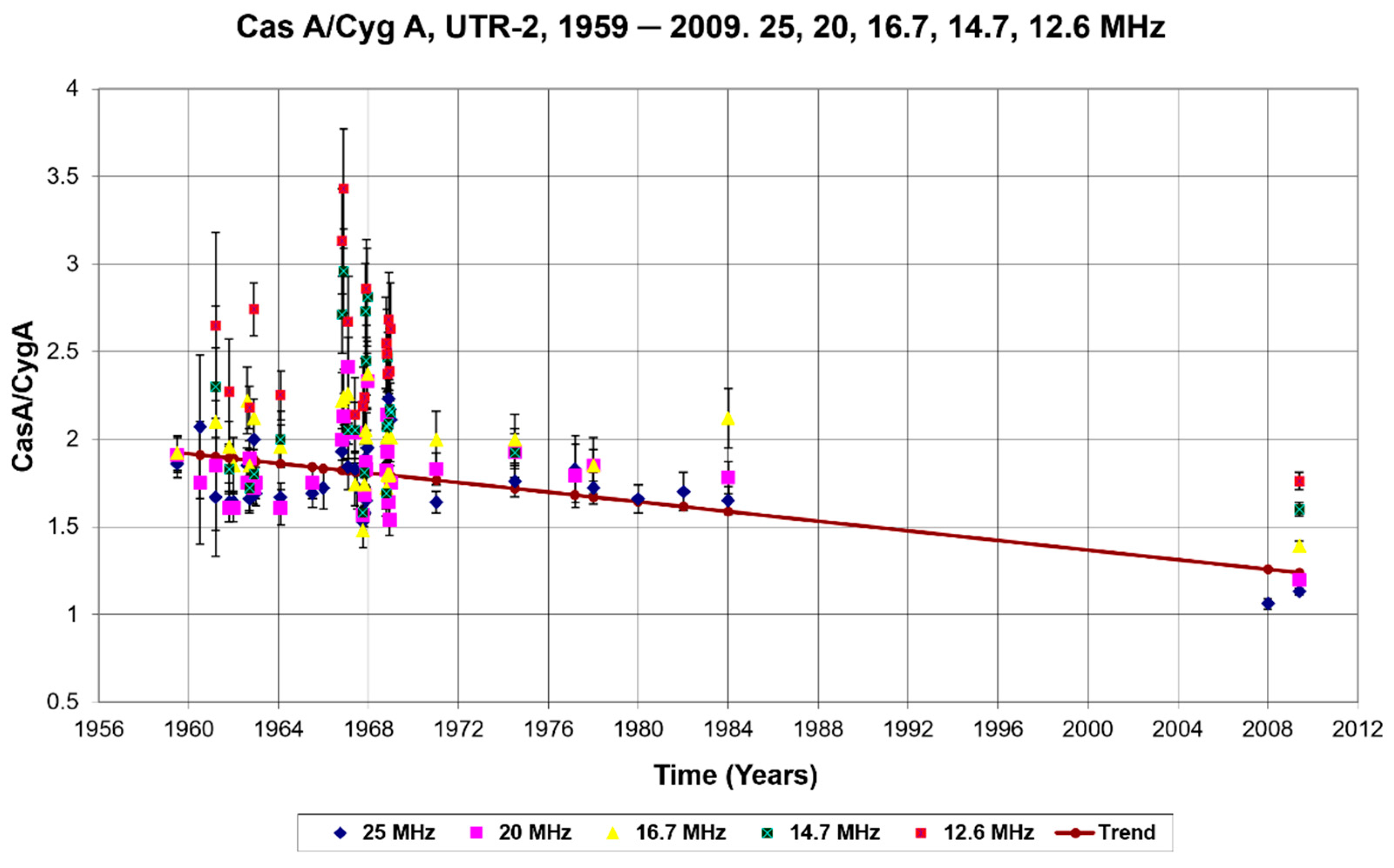
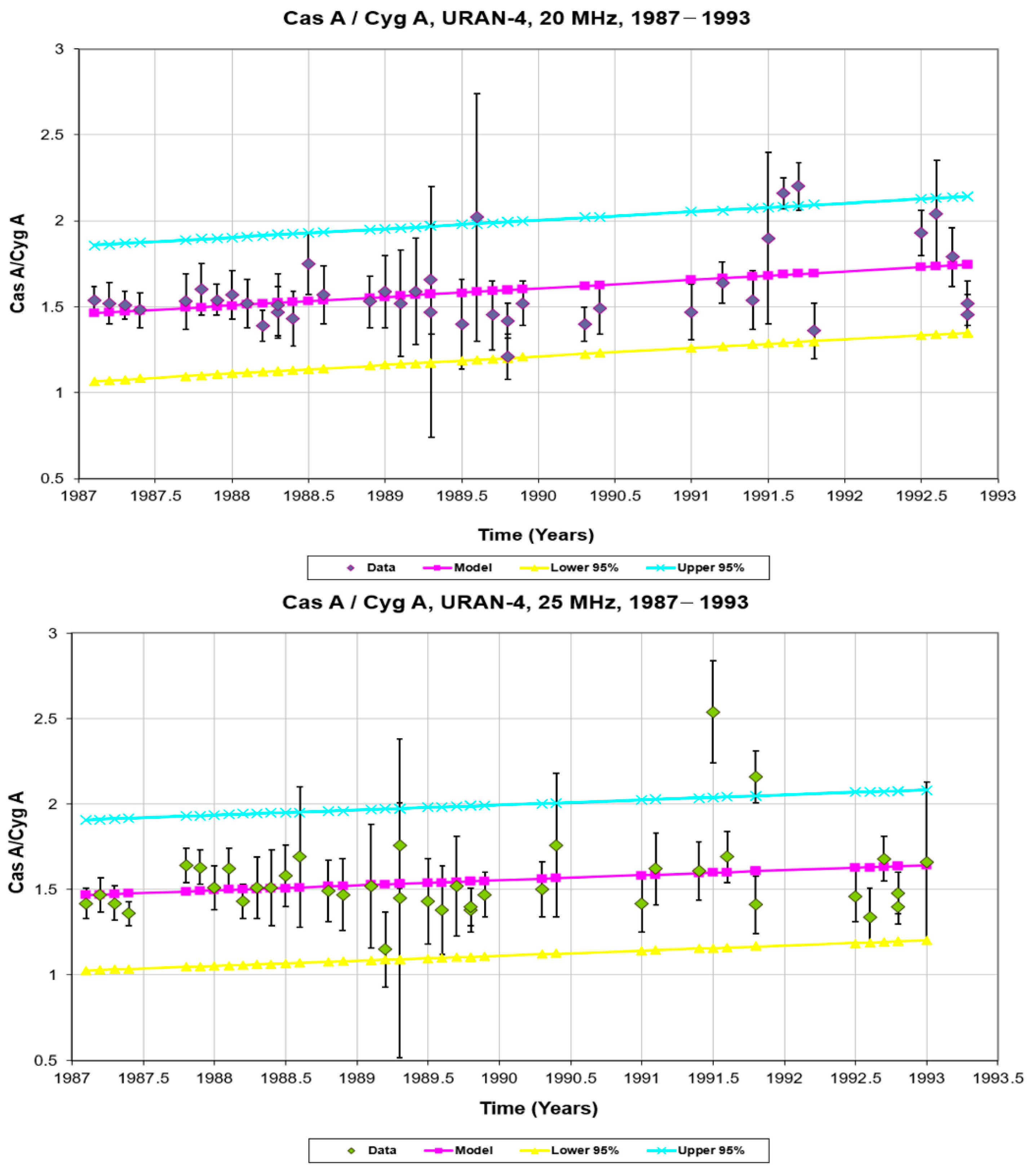
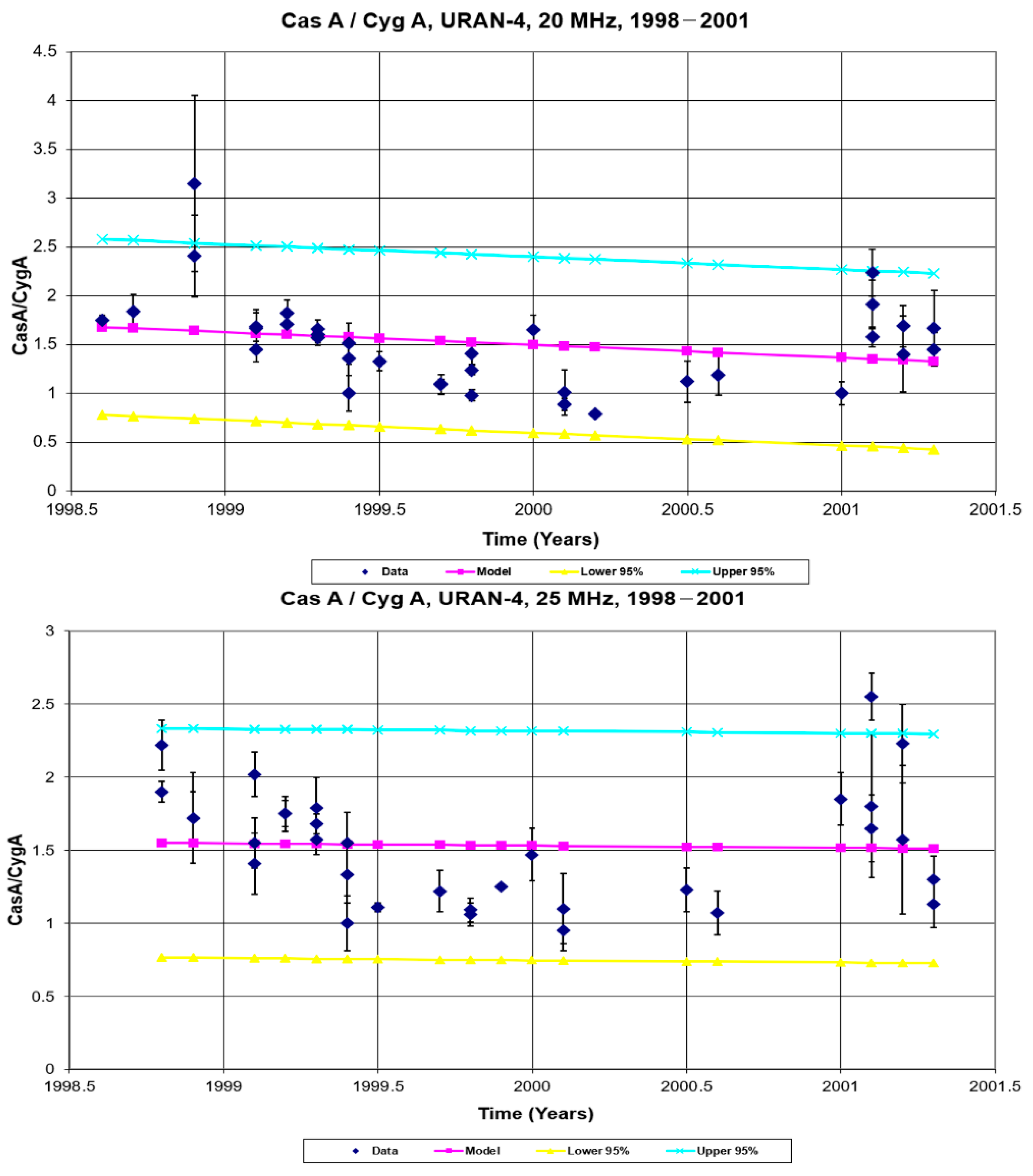
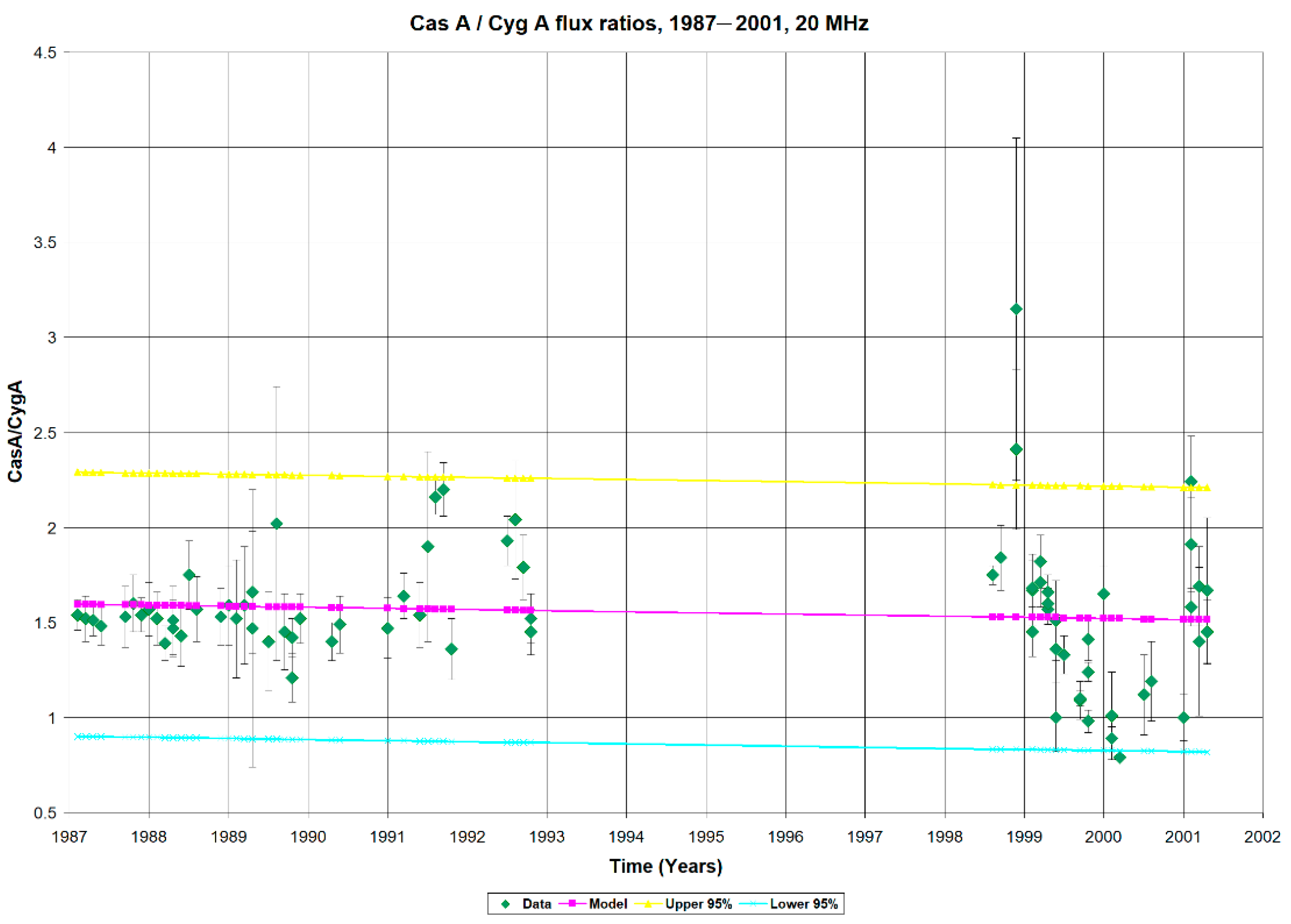
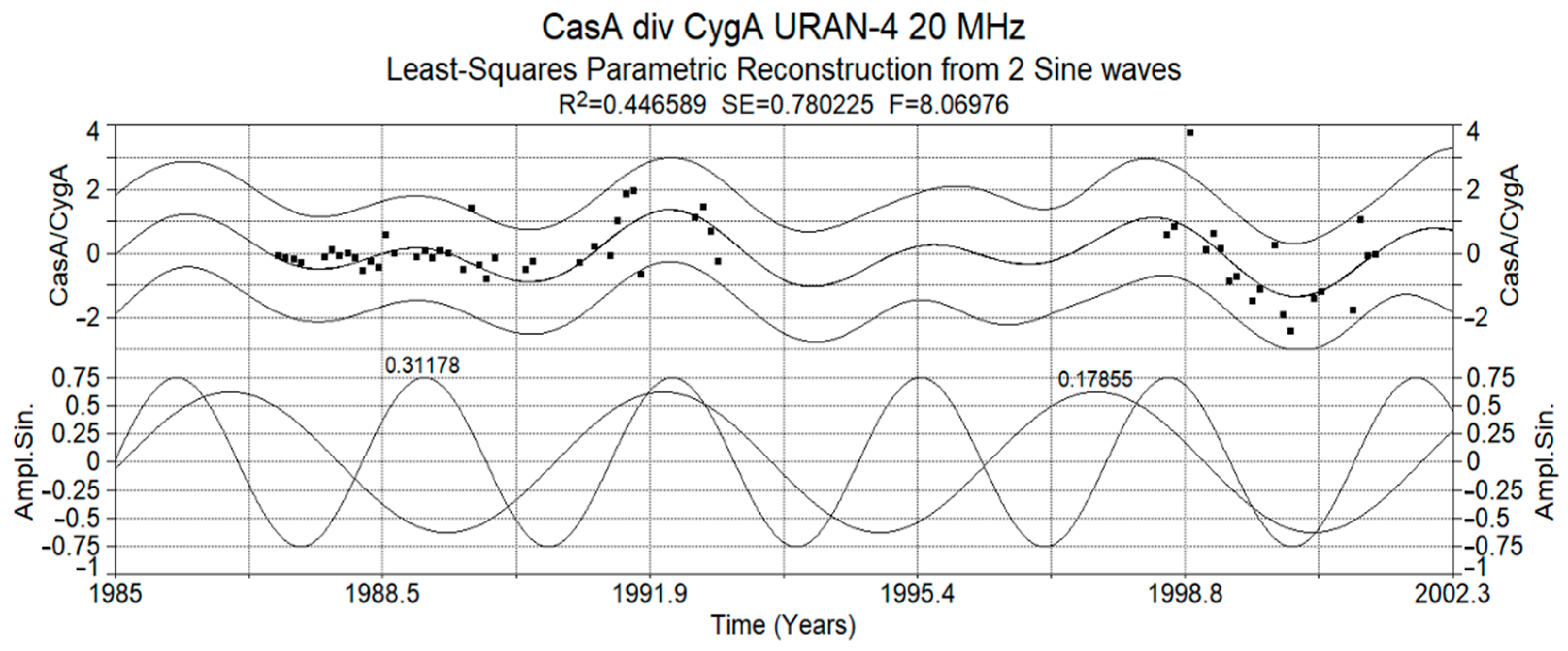
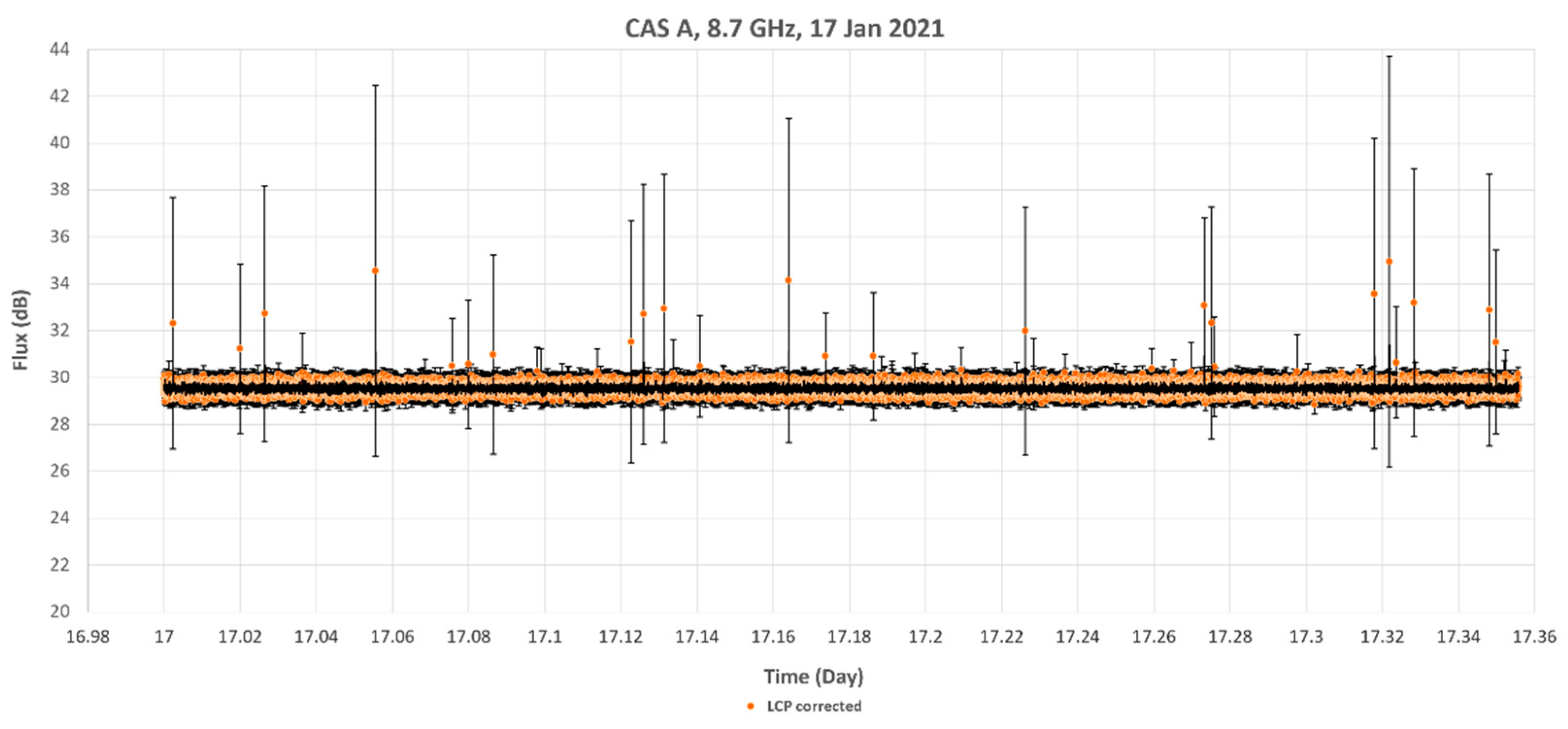
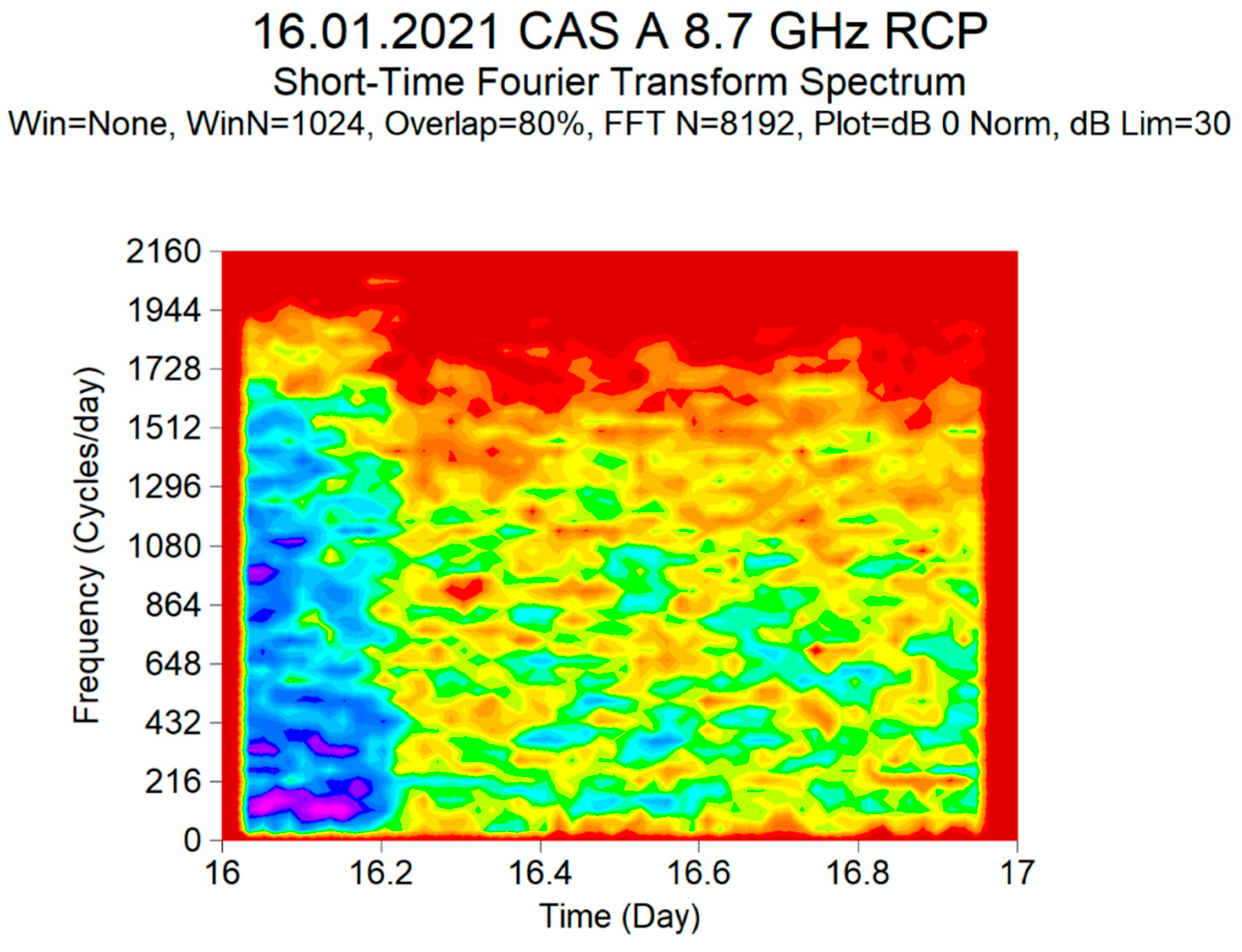
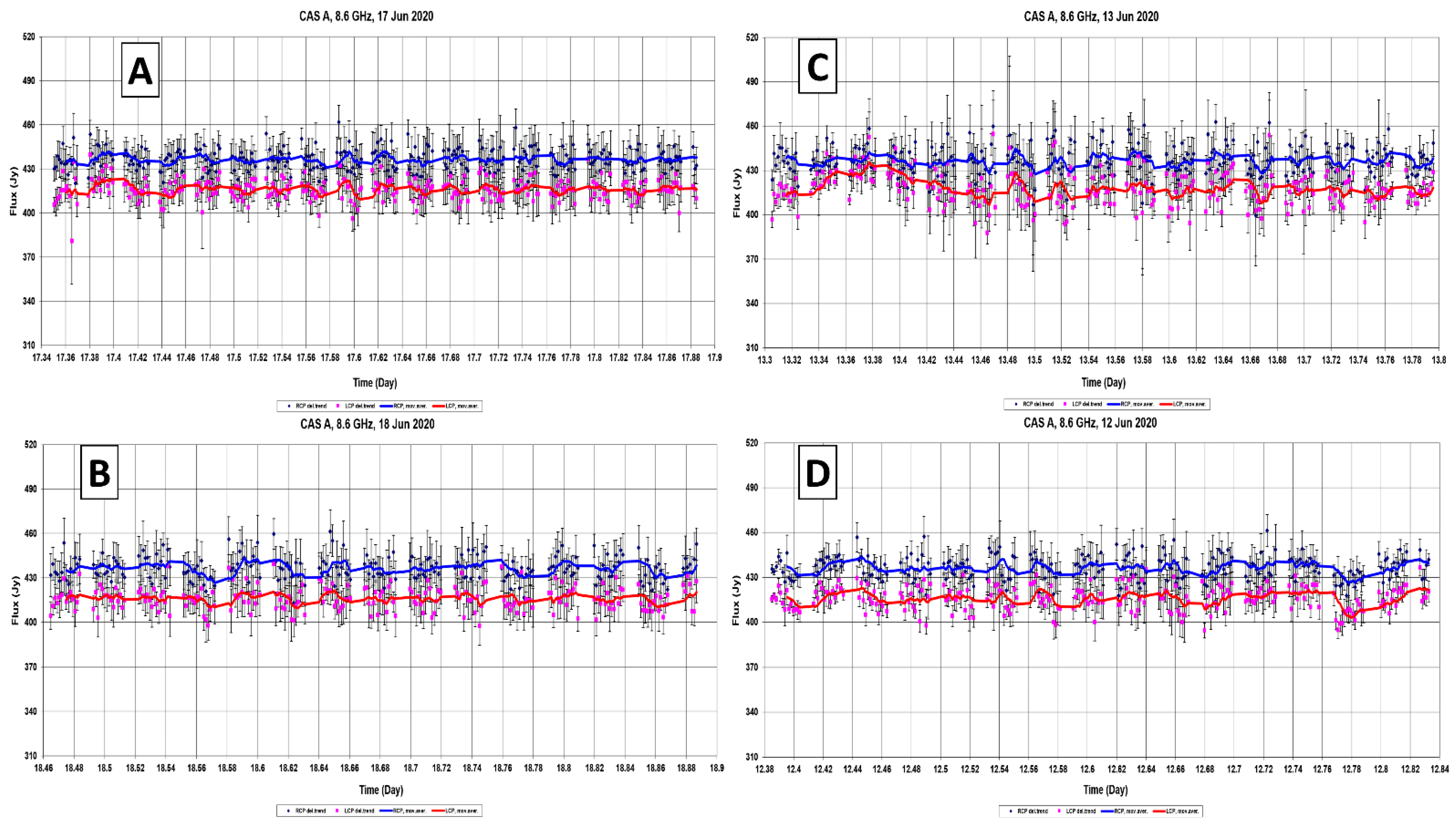
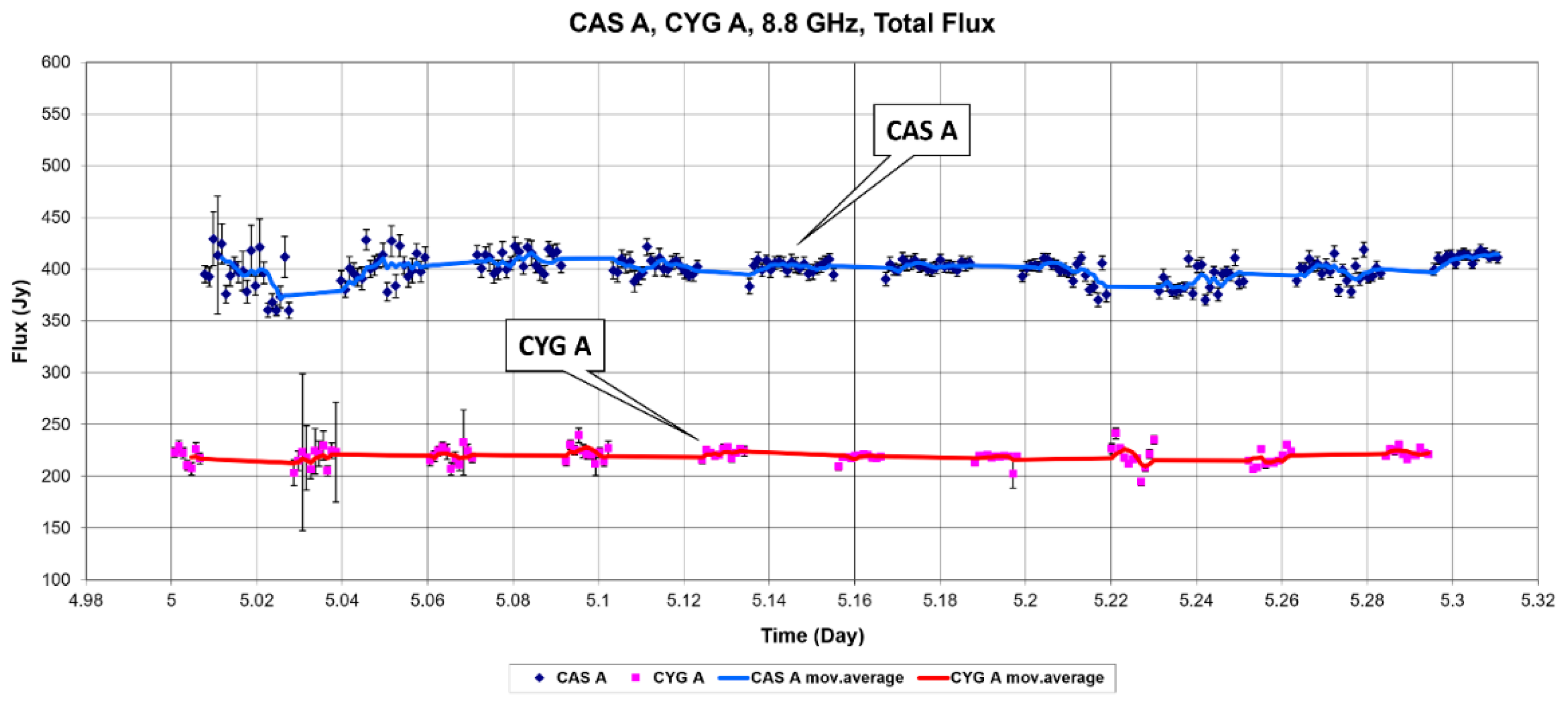
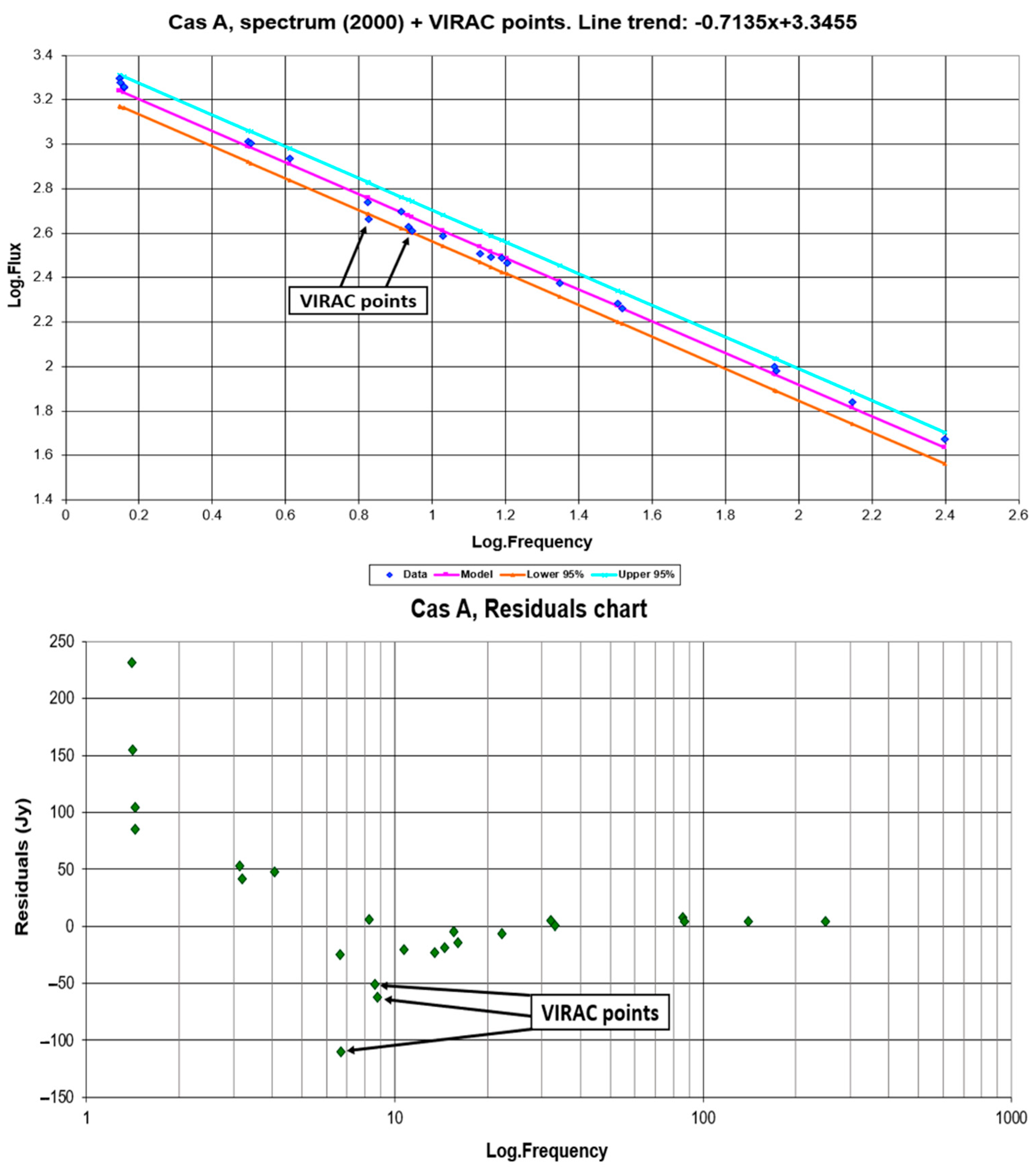
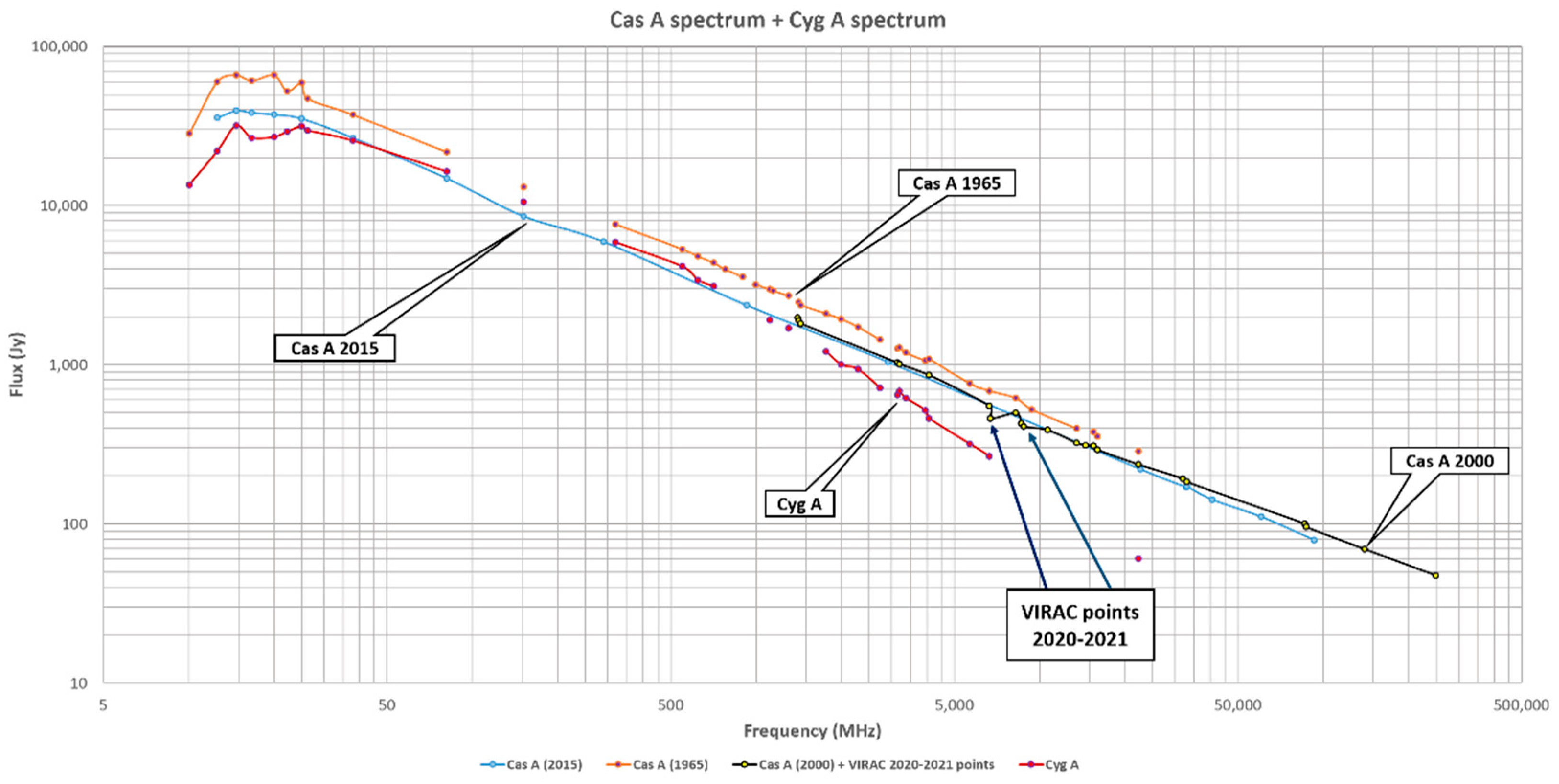
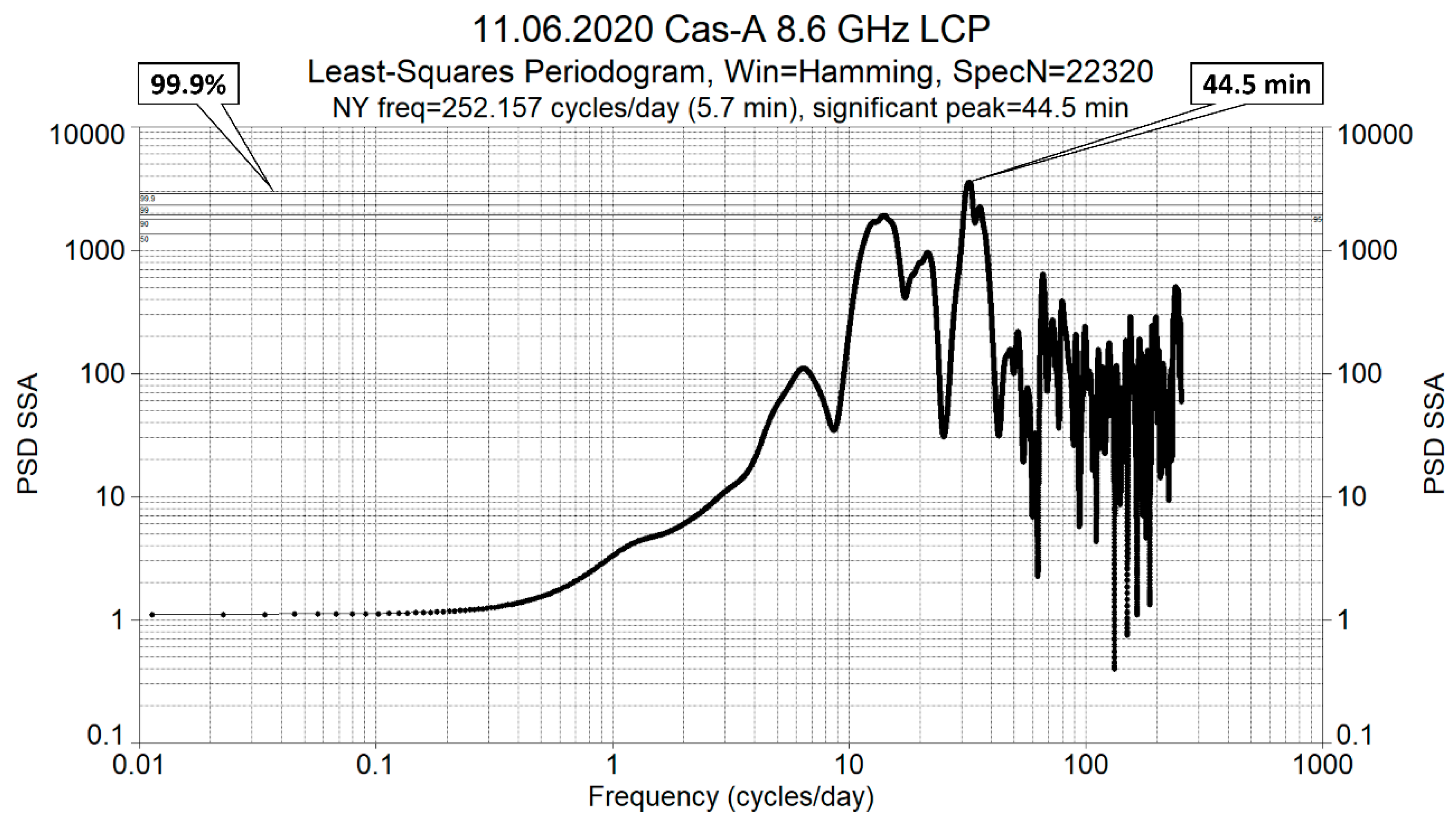
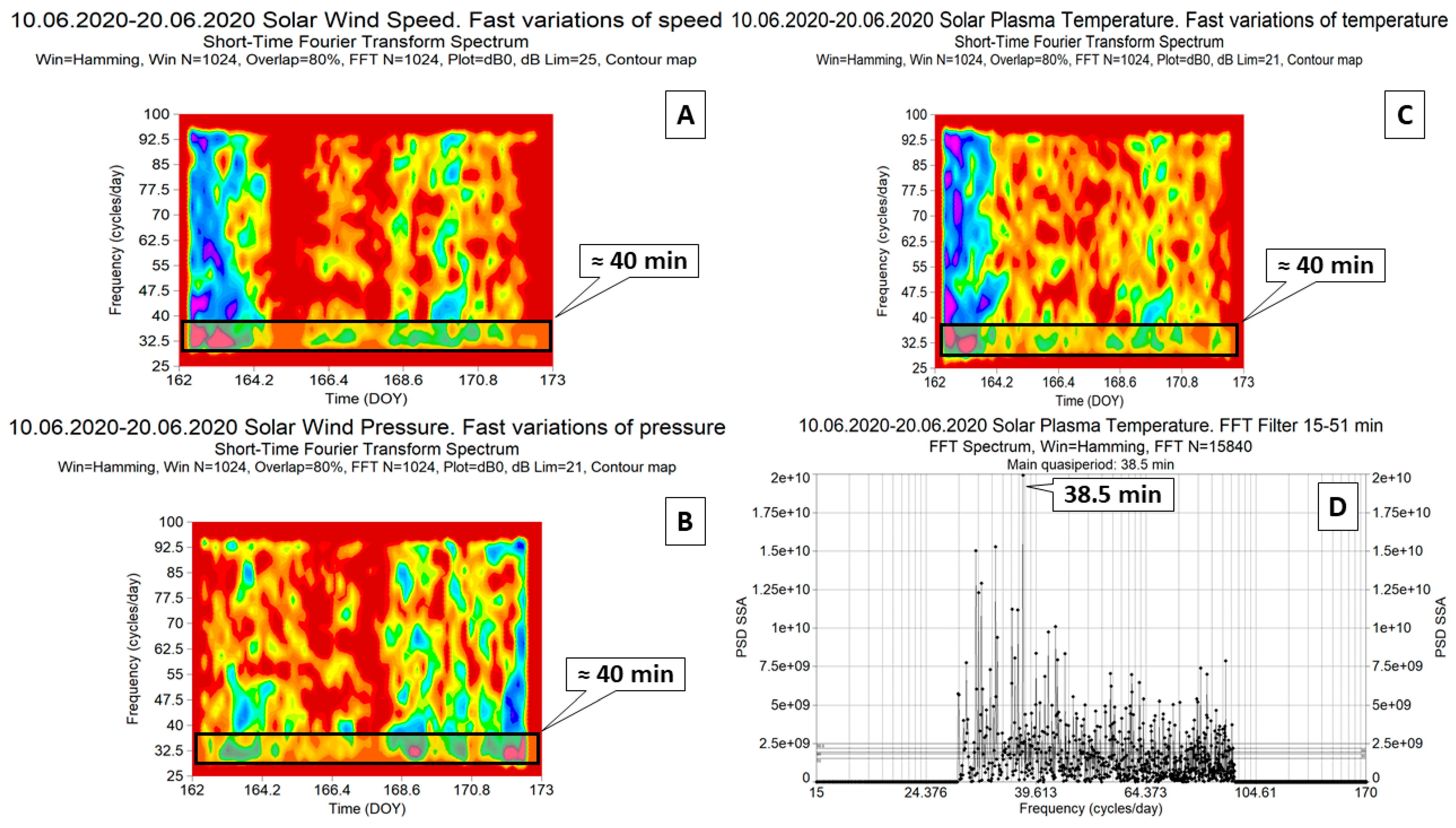
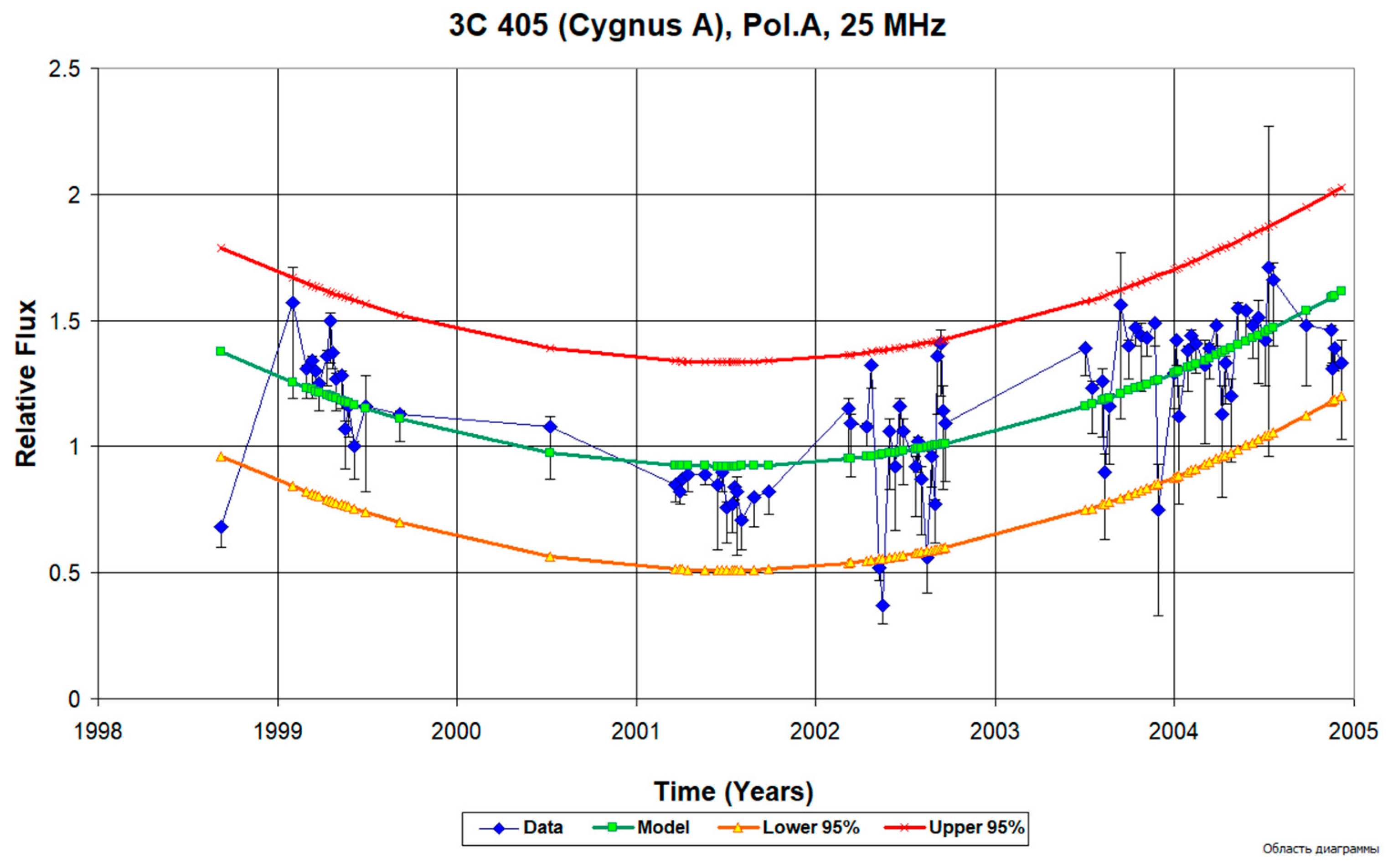
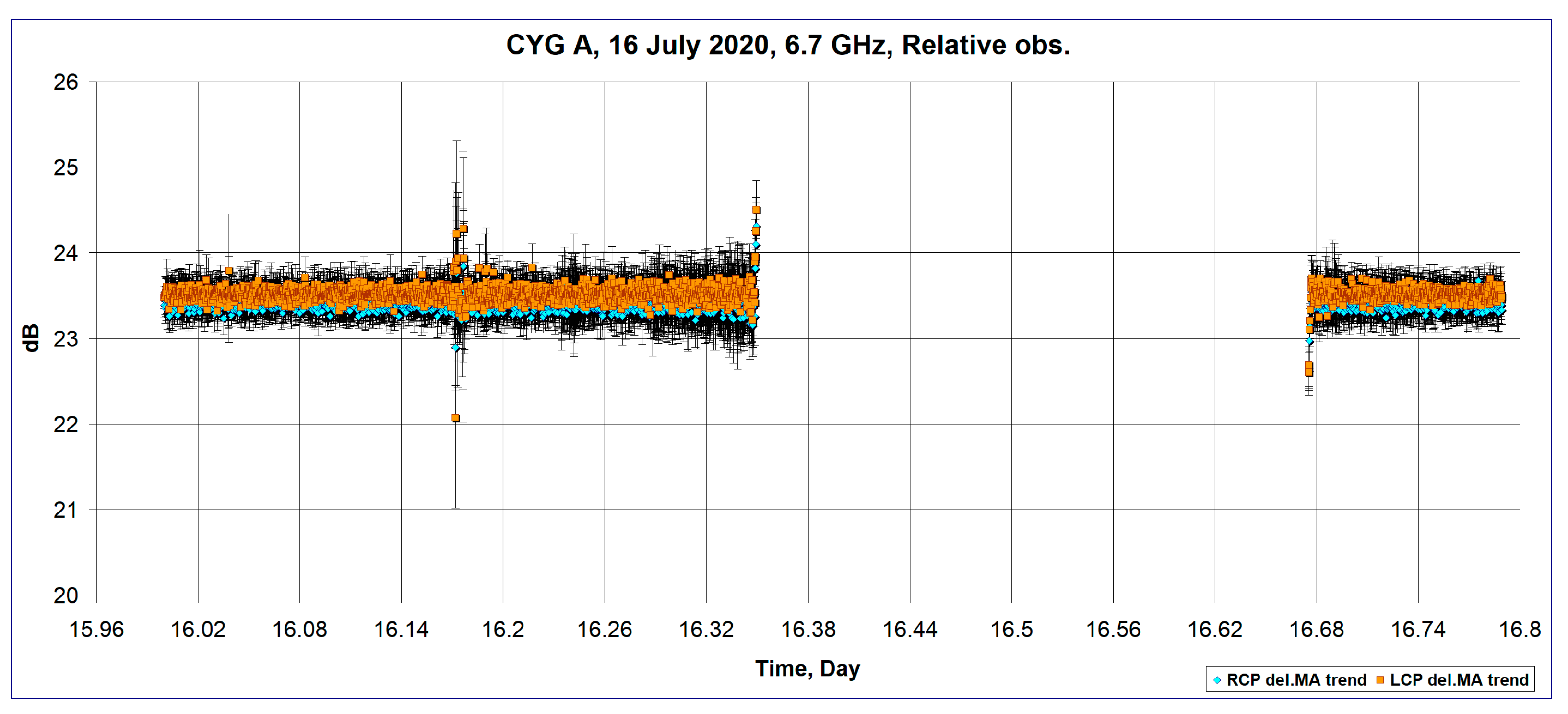
| Linear Regression Parameters for the UTR-2, 1959–2009, 25 MHz Data | |||||||||
|---|---|---|---|---|---|---|---|---|---|
| Coeff.A | Coeff.B | Disp.Data | Disp.Resid. | R2 | T-Stat.A | T-Stat.B | p-Val.A | p-Val.B | F-Stat. |
| −0.013707 | 28.782469 | 2.045443 | 1.232320 | 0.397529 | −4.805631 | 5.121110 | 0.999985 | 5.561 × 10−6 | 11.217129 |
| Linear Regression Parameters for 1987–1993, 20 MHz Data | |||||||||
| Coeff.A | Coeff.B | Disp.Data | Disp.Resid. | R2 | T-Stat.A | T-Stat.B | p-Val.A | p-Val.B | F-Stat. |
| 0.049631 | −97.1593 | 1.890498 | 1.593932 | 0.156871 | 2.693751 | −2.65037 | 0.005182 | 0.994222 | 3.535117 |
| Linear regression parameters for 1987–1993, 25 MHz data | |||||||||
| Coeff.A | Coeff.B | Disp.Data | Disp.Resid. | R2 | T-Stat.A | T-Stat.B | p-Val.A | p-Val.B | F-Stat. |
| 0.029646 | −57.4414 | 2.03431 | 1.92428 | 0.054087 | 1.474055 | −1.43536 | 0.074352 | 0.920317 | 1.057829 |
| Linear regression parameters for 1998–2001, 20 MHz data | |||||||||
| Coeff.A | Coeff.B | Disp.Data | Disp.Resid. | R2 | T-Stat.A | T-Stat.B | p-Val.A | p-Val.B | F-Stat. |
| −0.12993 | 261.3494 | 7.37616 | 6.97131 | 0.054886 | −1.38435 | 1.392408 | 0.912229 | 0.086556 | 0.929179 |
| Linear regression parameters for 1998–2001, 25 MHz data | |||||||||
| Coeff.A | Coeff.B | Disp.Data | Disp.Resid. | R2 | T-Stat.A | T-Stat.B | p-Val.A | p-Val.B | F-Stat. |
| −0.01493 | 31.38556 | 4.976097 | 4.970941 | 0.001036 | −0.17931 | 0.188519 | 0.57057 | 0.425849 | 0.015558 |
| Linear Regression Parameters for 1987–2001, 20 MHz Data | |||||||||
|---|---|---|---|---|---|---|---|---|---|
| Coeff.A | Coeff.B | Disp.Data | Disp.Resid. | R2 | T-Stat.A | T-Stat.B | p-Val.A | p-Val.B | F-Stat. |
| −0.00578 | 13.08551 | 9.382253 | 9.311466 | 0.007545 | −0.75004 | 0.851125 | 0.772195 | 0.198723 | 0.277476 |
| VIRAC, Latvia, 16-m Parabolic Radiotelescope Technical Data | |
|---|---|
| Cooled receiving system for the frequency range C/M/X | Manufacturer: TTI, Spain Frequency range: 4500–8800 MHz RHCP/LHCP Registration band: 1000–1200 MHz Available sub-bands: C1: 4500–5500 MHz, LO = 4100 MHz C2: 5400–6400 MHz, LO = 5000 MHz C3: 6400–7600 MHz, LO = 6100 MHz C4: 7600–8800 MHz, LO = 7300 MHz SEFD (C1/C2/C3/C4 for all bands): 540–700 Jy G/T: 56–60 dB/K Gain: ~0.05 K/Jy, 59 dBi System temperature: 30–50 K depending of elevation angle HPBW @ 8400 MHz: 0.156 deg или 10 arcmin |
| Antenna positioning system parameters: | Developer: MTM Mechatronics, Germany Azimuth/Elevation Range: −328…+328 deg/+2.5…94 deg Azimuth/Elevation maximum speed: 5/4 deg/s Azimuth/Elevation maximum acceleration: 1.5/2 deg/s/s Azimuth/Elevation tracking accuracy: 3.3/3.3 arcsec (RMS) Azimuth/Elevation guidance accuracy: 23/54 arcsec (RMS) Operating modes: Coordinate table; amendment table; TLE (for satellites) |
| Standard Deviations for the Cas A Data at 8.6 GHz | |||||||
|---|---|---|---|---|---|---|---|
| 12 June 2020 | 13 June 2020 | 17 June 2020 | 18 June 2020 | ||||
| RCP | 7.88 Jy | RCP | 10.46 Jy | RCP | 7.21 Jy | RCP | 8.22 Jy |
| LCP | 8.03 Jy | LCP | 11.60 Jy | LCP | 7.22 Jy | LCP | 7.93 Jy |
| Linear Regression Parameters for Cas A Radio Spectrum (2000) + VIRAC Points | |||||||||
|---|---|---|---|---|---|---|---|---|---|
| Coeff.A | Coeff.B | Disp.Data | Disp.Resid. | R2 | T-Stat.A | T-Stat.B | p-Val.A | p-Val.B | F-Stat. |
| −0.71355 | 3.345548 | 4.774494 | 0.028729 | 0.993983 | −60.2841 | 231.629 | 1 | 0.000001 | 1734.493 |
| Polynomial Regression Parameters for the Cyg A, 1999–2005, 25 MHz Data | ||||||
|---|---|---|---|---|---|---|
| Pc | Lo. 95% | Up. 95% | T-Stat | p-Val | Additional Stat.Parameters | |
| −2.1× 10−8 | −6.0 × 10−8 | 1.8 × 10−8 | −1.06951 | 0.856029 | Disp.D | 7.100595 |
| 0.000156 | −7.6 × 10−5 | 0.000388 | 1.316448 | 0.095824 | Disp.R | 3.681786 |
| −0.37037 | −0.83484 | 0.09409 | −1.56292 | 0.939062 | R2 | 0.481482 |
| 285.8209 | −23.9934 | 595.6352 | 1.808175 | 0.037101 | F-Stat | 19.03576 |
Publisher’s Note: MDPI stays neutral with regard to jurisdictional claims in published maps and institutional affiliations. |
© 2021 by the authors. Licensee MDPI, Basel, Switzerland. This article is an open access article distributed under the terms and conditions of the Creative Commons Attribution (CC BY) license (https://creativecommons.org/licenses/by/4.0/).
Share and Cite
Gorbynov, A.; Sukharev, A.; Ryabov, M.; Bezrukovs, V.; Orbidans, A. Features of Secular Changes in the Flux Density of the Cas a Supernova Remnant, from Centimeter to Decameter Wavelengths. Galaxies 2021, 9, 30. https://doi.org/10.3390/galaxies9020030
Gorbynov A, Sukharev A, Ryabov M, Bezrukovs V, Orbidans A. Features of Secular Changes in the Flux Density of the Cas a Supernova Remnant, from Centimeter to Decameter Wavelengths. Galaxies. 2021; 9(2):30. https://doi.org/10.3390/galaxies9020030
Chicago/Turabian StyleGorbynov, Artem, Artem Sukharev, Michail Ryabov, Vladislavs Bezrukovs, and Arturs Orbidans. 2021. "Features of Secular Changes in the Flux Density of the Cas a Supernova Remnant, from Centimeter to Decameter Wavelengths" Galaxies 9, no. 2: 30. https://doi.org/10.3390/galaxies9020030
APA StyleGorbynov, A., Sukharev, A., Ryabov, M., Bezrukovs, V., & Orbidans, A. (2021). Features of Secular Changes in the Flux Density of the Cas a Supernova Remnant, from Centimeter to Decameter Wavelengths. Galaxies, 9(2), 30. https://doi.org/10.3390/galaxies9020030






